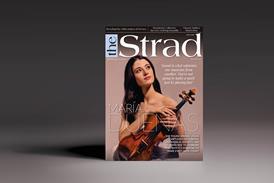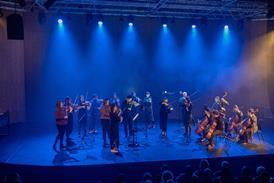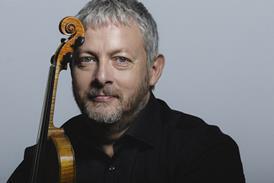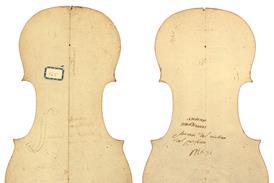Strings have played a fundamental role in the history of film music, but exactly what makes them so effective at ‘tapping into the invisible’?

This article was first published in the February 2016 issue of The Strad
The stage is set for an epic confrontation. In a large, murky room, James Bond comes face to face with the man responsible for many of the world’s ills – and for several of his personal losses. ‘It was me, James, the author of all your pain,’ says Ernst Stavro Blofeld, mastermind of the nefarious Spectre organisation. On paper, the scene, so familiar in its clichés, might sound laughable. But in the darkened cinema, with composer Thomas Newman’s tense tremolo strings humming through surround sound speakers, the audience is rapt. Simply put, the scene – and indeed much of the film – would not be effective without its soundtrack, and the contribution made by the string section to this (or any) symphonic film score cannot be rated highly enough.
Bernard Herrmann, composer of the oft-quoted – and purely string – soundtrack to Psycho (1960), famously said that director Alfred Hitchcock ‘only finishes a picture 60 per cent. I have to finish it for him.’ In a recorded interview, now housed in the Museum of Modern Art, New York, Herrmann went on to explain: ‘Film music must supply what actors cannot say – it must convey to an audience their feelings. It must really convey what the word cannot do.’ But it is also music’s function to ‘cement the segments [of a narrative] into one design, so that the audience feels the sequence is inevitable. ‘The strange thing about cinema is that nobody really knows why music is needed – after a lifetime, I’m not sure – but it is not complete without it.’
Herrmann’s view, that film music essentially performs both a practical function and an emotional one, is shared by French composer Alexandre Desplat, who has scored a variety of films including two Harry Potter blockbusters, contemporary US terrorism drama Zero Dark Thirty and British historical piece The King’s Speech.
One must understand ‘that film music ultimately serves the movie’, he says. ‘Most important is finding the balance between function and fiction. Function will ensure that the music fits well into the mechanics of the film, but fiction enables you to tap into the invisible – the deep psychology and pain of the characters. It has a very special strength, but only works when balanced equally with function, because the music cannot be detached from the story.’
So how do strings contribute to this delicate balance? Perhaps the most obvious use for strings in film is in scenes of great emotional depth. Gone with the Wind’s epic romance (1939), in which spirited southern belle Scarlett O’Hara falls for both the noble Ashley Wilkes and the sardonic Rhett Butler, is ably abetted by Max Steiner’s sweeping melodies. Snap forward just over 40 years to an entirely different time and setting, and strings continue to signal a deep love – this time felt by lonely Elliott for alien E.T. in Steven Spielberg’s perennial children’s classic (1982). Here, John Williams’s captivating strings not only rise and rise to encompass the freedom and joy of flying, as Elliott’s bicycle sweeps across the moonlit sky, but also express the bittersweet pain and loss as E.T. is finally reunited with his parents, and Elliott must say goodbye to his friend – and his childhood – at the film’s conclusion.
These examples, just two in a countless list of instances, demonstrate strings’ ability to move and engage an audience, and to cut to the emotional core of a storyline. But just why strings are so effective at doing so is a matter of some discussion.
‘Strings are so expressive,’ hypothesises Javier Navarrete, composer of the Oscar-nominated soundtrack to Guillermo del Toro’s 2006 film Pan’s Labyrinth. ‘You might think because of the element of breathing, that winds might be more expressive, but this is not the case.’ Likewise, the British composer Patrick Doyle, long-time collaborator with actor-director Kenneth Branagh, says: ‘the violin is so similar to a human voice, it touches us all instantly. Strings are so evocative – they immediately create a visceral, emotional response. The combination of harmony and strings can have quite a devastating emotional impact.’
It’s a phenomenon that composer John Murphy experienced first-hand when scoring his Adagio in D minor for Danny Boyle’s Sunshine in 2007: ‘It’s funny, but one of the things Danny and I agreed on before I started Sunshine was “definitely no strings”,’ he recalls. The two wanted to use other instruments to convey the cold alien environment of space and to avoid repeating the numerous ‘space scores’ that already existed. ‘But we then shot the scene where Kaneda sacrifices himself to save the spaceship so the crew can save the world,’ says Murphy. ‘It was such a grand, beautiful scene that in the end we thought, “Screw it, let’s just go for it and see how it feels.” Because there were so many non-orchestral sounds mixed in there – synths, kicks, distortions, backwards loops and so on – and because of the gravity and scale of the scene, the strings didn’t feel out of place. I can’t imagine the film without strings now. They gave the score its humanity.’
Yet it’s not just in grand, emotional scenarios where strings are important for cinematic storytelling. As composer John Williams said in a 1997 interview with Total Film magazine, ‘Movie music is often banal and simplistic, mostly because it has to be, as we don’t have the listener’s attention, and if we expect to have it we’ll write a bad film score.’
Strings’ ability to remain unobtrusively in the background, then, to add a flavour of emotion or tension while allowing dialogue and storyline to take centre stage, is of paramount importance. ‘Strings don’t cloud the dialogue,’ explains Doyle. ‘You have to be very careful when using some instruments in conjunction with words: the flute, which is high-pitched and piercing, is an obvious example. However, high-pitched strings can be played softly and delicately (it’s not a hard sound), so they don’t intrude on dialogue. They can create an entire sound world while allowing the audience to follow a narrative.’ Navarrete cites Newman as a particular master of understated string writing (for example in the 1994 film The Shawshank Redemption). ‘Newman is so clever with his use of sound,’ he says. ‘He uses a great deal of divisi in his string section, so there can be 16 different parts in an incredibly complicated arrangement, and yet it sounds so simple. It’s complex writing with a very humble result.’
This special versatility of the string section – the ability to transform a score from barely there nuance to epic, uplifting grandeur – is about far more than dynamic and harmonic range. Of course, a section of multiple players must necessarily possess the ability to turn up the volume, both sonically and emotionally: ‘I love the way that you can creep from nothing and crescendo to a violent cacophony all in one moment,’ says Murphy. Yet, the nature of stringed instruments themselves, the sheer number of effects possible, ensures that violins, violas, cellos and basses are especially well equipped to convey a whole range of human feelings beyond the obvious love and romance with which they are most readily associated.
Dominique ‘Solrey’ Lemonnier, concertmaster and artistic director for Desplat’s film scores, has helped the composer to distance his strings from mawkishness. ‘We work to deliver emotion without pathos; sentiment without sentimentalism,’ she says. ‘Strings in movie soundtracks are conventionally used to drive the music into romantic territory, but in his compositions Alexandre has called upon my knowledge of Baroque, tango, Classical, Minimalist, jazz and contemporary music, striving for a purity of sound without excessive vibrato. We also work to create fluid bowing, using many different speeds, alternating weight and lightness, travelling from sul tasto to sul ponticello.’
Doyle is similarly preoccupied with using the gamut of string sounds. ‘You can play harmonics, pizzicato, legato, staccato, spiccato, sul ponticello, col legno and God knows what else,’ he enthuses.
‘In action films like Jack Ryan: Shadow Recruit [2014], which I recently scored, strings can provide wonderful motor themes,’ he continues. ‘If they are mixed quite high, they can protrude over the banging and crashing of sound effects and drive the action on screen. Way back in my first film score for Kenneth Branagh’s Henry V [1989] I used that same technique. Whenever the King galvanised his army on the way to Agincourt, the theme appeared in the cellos and violas.’
‘I don’t think there are any strict rules for where you would use strings to illustrate a scene,’ agrees Murphy. ‘I’ve used strings in some strange places, where they really shouldn’t have worked, but where the juxtaposition of music and action has made all the difference. In Lock, Stock and Two Smoking Barrels [1998], which had a pretty dirty, lo-fi little score, there’s a very violent scene towards the end where Big Chris kills a man by smashing his head repeatedly with a car door. However, there is an emotional rationale behind his actions – the man was threatening Chris’s child with a knife; so instead of obvious “violent” music, I wrote a more internal, poignant piece on strings and it lent an entirely different element to an otherwise horrible, shocking scene.
‘You only have to watch Cinema Paradiso and Psycho back to back to see how versatile strings are. They can be warm or screeching, lyrical or apocalyptic.’
Indeed, some of string music’s most powerful and memorable moments have accompanied scenes of raw cinematic terror. However, perhaps as a result of the string sound’s traditional association with warmth and feeling, directors in the early stages of film making have taken some convincing of its potential to inspire fear. When man-versus-killer-shark classic Jaws became the first ‘blockbuster’ film upon its release in 1975, Spielberg was all too happy to admit that the score was ‘clearly responsible for half the success of that movie’. But when Williams first played him the now iconic two-note theme intended for cello and double bass he called the composer ‘crazy’. ‘He thought I was going to pull out a more romantic, pastoral score,’ remembered Williams in a 1980s television interview. ‘But I said, “No, you’ve made a very primal movie. Your movie’s about the dinosaurs, the ancient world, the land of the giants”.’ For Jaws, Williams had perfectly encapsulated Desplat’s notion of function and fiction: those deep, growling bass strings not only inspire fear and tension, but are also a very practical cue for the shark’s lurking presence.
Herrmann recounted a similar experience during the filming of Psycho. Hitchcock was adamant that he wanted ‘absolutely no music’ during the film’s now infamous shower scene, but the composer was unconvinced, instead envisaging a score completely for strings, a gnawing, nerve-racking work whose ‘screaming violins’ as Norman Bates violently slaughters the film’s heroine are but the tip of an iceberg that extends all the way to the shady and remote recesses of the human subconscious.
Doyle took the idea a step further by turning to the string quartet when scoring Branagh’s Hamlet (1996). ‘Shakespeare’s play is such an internal piece,’ he says. ‘For Hamlet’s stepfather, Claudius, I used a string quartet, which merges into a full string orchestra. the interplay between the quartet instruments, using modern and dissonant harmonies, helped me as a composer to access the mind of Claudius as he is wrestling with his soul.’
Doyle’s example illustrates the great complexity of emotion provided by strings when used to their fullest effect. That strings can so convincingly capture, on the one hand, the purity of a young boy’s love in E.T. and, on the other, the dark Freudian impulses of cinema’s most famous serial killer in Psycho is surely a testament to their versatility. More than this, however, their ability to tap into the primitive impulses behind human fear and doubt, love and grief, is perhaps the real reason that they are so devastatingly effective when used on screen. Ultimately, as Herrmann said, music – for strings in particular – is capable of encapsulating those thoughts and feelings which cannot be expressed through dialogue and plot, image and action.
This article was first published in the February 2016 issue of The Strad





























No comments yet